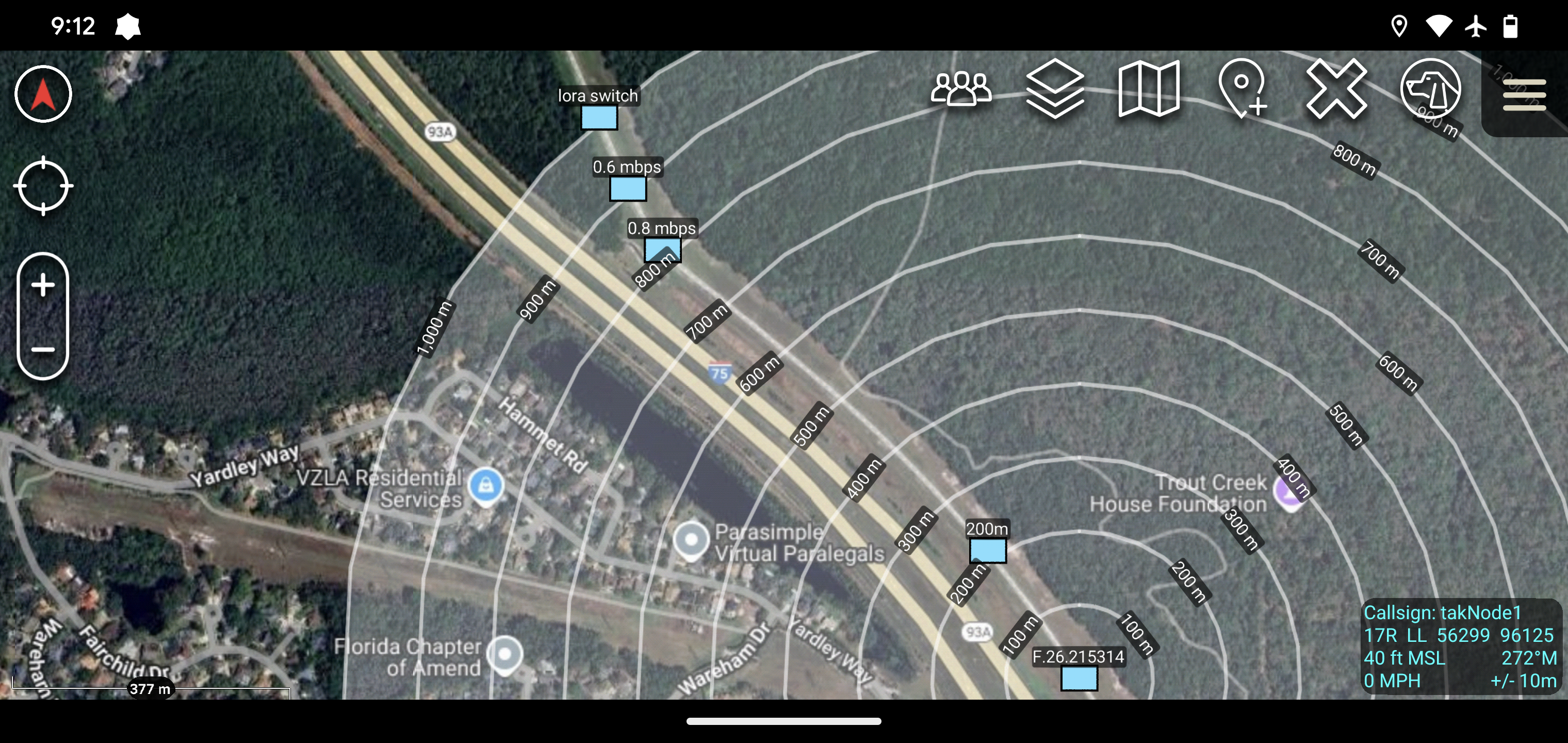Testing Data
Performance metrics and testing results for Natak Mesh products
WiFi Testing Results
This page presents field test results focusing on WiFi connection performance. These results show WiFi capabilities of the Nucleus V1 nodes only. The Nucleus V1 also includes an onboard RAK4631 Meshtastic radio for longer-range communication. More data will be added as it's acquired.
WiFi Range Test

WiFi Range Test
This test measures the maximum effective range of the WiFi mesh network between two Nucleus V1 nodes. These results are specific to the WiFi connection capabilities of the devices.
Test Setup
- Environment: Open field with clear line of sight
- Equipment: Two Nucleus V1 nodes with standard antennas
- Node Configuration: Both nodes at approximately 4' elevation, one static and one mounted on an OHV
- Measurement: Batman mesh statistics used to monitor data rates
WiFi Connection Results
- 800m: WiFi data rate dropped below 1 Mbps
- 900m: WiFi connection still maintained as shown in the image
- 900m-1km: WiFi connection completely lost
WiFi Throughput at Various Ranges

WiFi Throughput at Various Ranges
This test measures the WiFi data throughput capabilities of the Nucleus V1 nodes at different distances. All measurements reflect WiFi connection performance only.
Test Setup
- Environment: Test environment with varying terrain and obstacles
- Equipment: Three Nucleus V1 nodes with standard antennas
- Node Configuration: Node 1 (mobile) carried at ~4' elevation, Node 3 mounted at ~4' elevation, Node 2 placed at 0' elevation near ground clutter but with line of sight to Node 3 to force hopping behavior on the mesh
- Measurement: BATMAN mesh statistics used to monitor throughput rates
- Note: Data points related to "lora switch" were from an older version without full Meshtastic integration and are not relevant to this WiFi range discussion
WiFi Connection Results
- Clear Line of Sight: Good WiFi throughput maintained up to ~300m
- Obstructed Line of Sight: Trees blocking direct LoS reduced maximum WiFi range to ~500m
- Performance Drop-off: Sharp decrease in WiFi throughput after ~300m
- Maximum Range: WiFi connection completely lost beyond ~500m with obstructions
Additional WiFi Throughput Test

Additional WiFi Throughput Test
This test provides additional data on WiFi throughput capabilities under different conditions. All measurements shown are exclusively for WiFi connections.
Test Setup
- Environment: Test environment with more Line of Sight (LoS) obstructions than the previous test
- Equipment: Two Nucleus V1 nodes with standard antennas
- Node Configuration: Both nodes at approximately 4' elevation with direct connection between them
- Measurement: BATMAN mesh statistics used to monitor throughput rates
- Note: Data points related to "lora mode" were from an older version without full Meshtastic integration and are not relevant to this WiFi range discussion
WiFi Connection Results
- Throughput with Obstructions: WiFi throughput drops sharply once Line of Sight (LoS) is obstructed, down to approximately 1 Mbps by 300 meters
- Connection Stability: WiFi dropouts become noticeable at 350 meters, with WiFi connection mostly lost by 400 meters
- North Side Test Area: From 250m to 320m in relatively clear LoS, only a mild drop in WiFi throughput was observed
- Impact of Obstructions: Adding obstructions from 320m to 370m produced an extreme cut in WiFi throughput
- Conclusion: Line of Sight obstructions have a significant impact on WiFi throughput and connection stability, with a much sharper performance drop-off compared to clear LoS conditions
Meshtastic Radio Capabilities
Meshtastic Radio
The Nucleus V1 includes an onboard RAK4631 Meshtastic radio for longer-range communication. While WiFi provides high-bandwidth connections at shorter ranges, the Meshtastic radio enables much longer-range communication with lower bandwidth.
Meshtastic Range Tests
- For detailed range test data on Meshtastic radios, please visit the official Meshtastic range tests documentation.
- These tests demonstrate the significant range advantages of LoRa-based Meshtastic radios compared to WiFi.
- With the large knowledge base of Meshtastic users already documenting performance, we currently focus primarily on WiFi performance testing since Meshtastic performance characteristics are well-established.
- We plan to conduct our own Meshtastic field testing with the Nucleus V1 in the future to validate performance with our specific hardware configuration.
Power Draw During WiFi Operation
The node uses 5V via the provided USB A > M12 cable. Current draw during operation is ~0.5 A.
